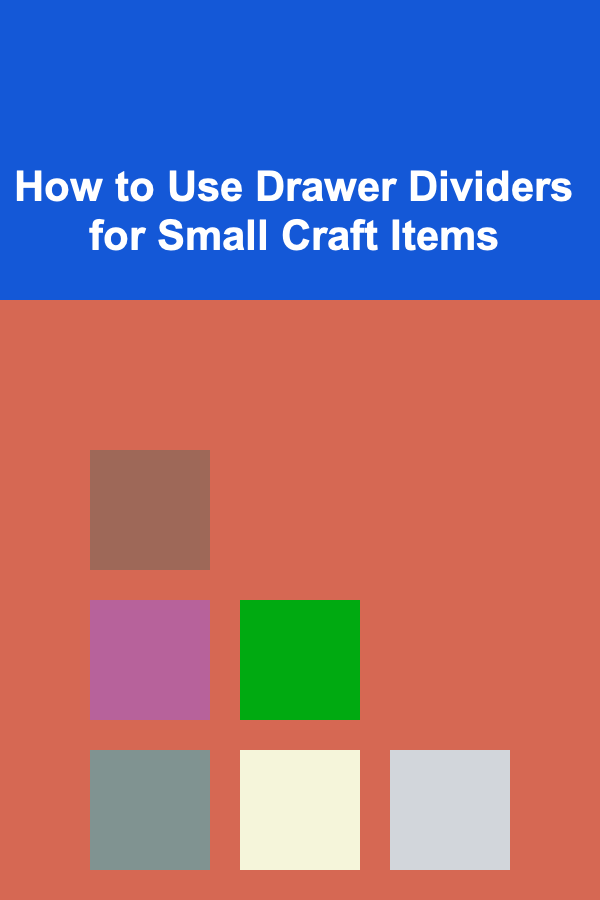
How to Use Drawer Dividers for Small Craft Items
ebook include PDF & Audio bundle (Micro Guide)
$12.99$6.99
Limited Time Offer! Order within the next:

Crafting is a delightful and rewarding pursuit that allows individuals to express their creativity. As any crafter knows, the tools and materials necessary for crafting can quickly accumulate and become disorganized. A well-organized workspace not only enhances productivity but also makes crafting more enjoyable. One effective way to achieve organization in drawers filled with small craft items is by using drawer dividers. This comprehensive guide will explore how to effectively use drawer dividers for small craft items, covering everything from selecting the right dividers to maximizing their utility.
Understanding the Benefits of Drawer Dividers
1. Improved Organization
Drawer dividers help keep similar items grouped together, making it easier to locate what you need without rummaging through an entire drawer.
2. Maximized Space
By sectioning off areas within a drawer, dividers allow you to utilize every inch of space efficiently. This maximization is particularly beneficial in smaller workspaces.
3. Reduced Clutter
Having designated spaces for each type of supply minimizes clutter, creating a more visually appealing and functional workspace.
4. Time Savings
When items are organized, you spend less time searching for supplies. This efficiency allows you to focus on your crafting rather than locating materials.
5. Enhanced Creativity
An organized environment fosters creativity. When everything is neatly arranged, you can find inspiration and get started on projects quickly.
Assessing Your Craft Supplies
Before implementing drawer dividers, it's crucial to assess your existing craft supplies to understand what needs organizing.
1. Gather All Supplies
Collect all your small craft items into one area. Commonly used small items include:
- Beads
- Buttons
- Ribbons
- Embellishments
- Scissors
- Adhesives
- Threads
- Markers
2. Sort by Category
Sort your items into categories based on their function or type. Categories could include:
- Sewing Supplies: Threads, needles, pins
- Beading Supplies: Beads, wires, tools
- Paper Crafts: Stickers, washi tape, paper clips
- General Tools: Scissors, adhesives, rulers
3. Evaluate Quantity
Take note of how many items you have in each category. This evaluation helps determine the number and size of dividers needed.
Choosing the Right Drawer Dividers
Selecting the appropriate dividers is key to achieving organized drawers. Here are some factors to consider:
1. Material
Dividers come in various materials, including:
- Plastic: Lightweight and affordable; easy to clean.
- Wood: Sturdy and aesthetically pleasing, but may be pricier.
- Cardboard: Inexpensive but less durable; good for temporary solutions.
2. Adjustable vs. Fixed
Consider whether you want adjustable dividers that can be resized to fit your specific needs or fixed dividers that remain in place.
3. Height and Depth
Ensure the dividers you choose fit comfortably within your drawers. They should be tall enough to prevent items from toppling over but not so tall that they impede drawer closure.
4. Style
Select a style that complements your overall workspace. There are decorative options available that can add a personal touch to your storage solution.
Preparing Your Drawers
Once you've chosen your dividers, it's time to prepare your drawers for organization.
1. Clean the Drawers
Empty out your drawers completely and give them a thorough cleaning. Dust and debris can accumulate over time, so ensure they are clean before adding dividers.
2. Assess Drawer Dimensions
Measure the width, depth, and height of your drawers. This information will guide you in selecting the correct sizes for dividers.
3. Plan the Layout
Visualize how you want to organize your supplies within the drawer. Sketch out a layout plan that aligns with your categories.
Organizing Small Craft Items
With the dividers ready and the drawers prepared, it's time to organize your small craft items.
1. Place Dividers
Install the dividers according to your planned layout. If using adjustable dividers, adjust them to create the necessary compartments.
2. Group Similar Items
As you place items into their respective sections, group similar supplies together. For example, keep all sewing supplies in one compartment and all beading supplies in another.
3. Avoid Overcrowding
Don't cram too many items into one section. Leave some extra space to allow for easy access, and avoid frustration when retrieving supplies.
4. Use Clear Containers
For very small items, consider using clear containers within the compartments. This approach prevents tiny items from getting lost.
Maximizing Space with Dividers
To make the most of your drawer space, consider these strategies:
1. Vertical Storage
If your drawers are tall enough, consider vertical storage solutions such as upright containers for scissors or rulers. This method utilizes vertical space effectively.
2. Nested Items
For certain supplies like spools of thread or rolls of ribbon, nest smaller items within larger ones to free up space.
3. Dual-Purpose Items
Use dual-purpose organizers that can serve multiple functions. For example, a small bin that holds beads and can also act as a weight for fabric crafts.
4. Seasonal Rotation
If you have seasonal items, consider rotating them in and out of the drawer. Keep off-season items stored elsewhere to maintain a tidy workspace.
Labeling for Easy Identification
Labels play a crucial role in maintaining organization, especially when using dividers.
1. Choose Labeling Method
Select a labeling method that works best for you. Options include:
- Handwritten Labels: Simple and customizable; use washi tape or sticky notes.
- Printed Labels: More polished appearance; consider a label maker for consistency.
- Color-Coded Labels: Assign different colors for categories to enhance visual identification.
2. Position Labels Clearly
Attach labels at the front of each compartment to provide immediate visibility. Ensure labels are large enough to be read easily.
3. Update Labels Regularly
As you add or remove items, update labels accordingly. Maintaining relevance ensures continued organization.
Maintaining Your Organized Drawers
Organizing is just the first step; ongoing maintenance is essential for long-term success.
1. Regular Check-Ins
Schedule regular check-ins (e.g., monthly or quarterly) to review the organization of your drawers. Tidy up as needed and ensure everything is in its designated spot.
2. Declutter Periodically
Every few months, go through your supplies and declutter any items you no longer use. Consider donating or recycling unused materials.
3. Reassess Needs
As your crafting interests evolve, your organizational needs may change. Be flexible and willing to adapt your system as necessary.
4. Educate Others
If you share your crafting space with family members or friends, educate them about your organization system. Encourage them to respect the arrangement and contribute to its upkeep.
Common Challenges and Solutions
Even with careful planning, challenges may arise. Here are some common issues and their solutions:
Challenge: Limited Space
Solution: If drawer space is limited, consider utilizing other storage options such as rolling carts, pegboards, or wall-mounted organizers.
Challenge: Difficulty Finding Items
Solution: If you find yourself frequently losing items, reassess your labeling system. Make sure labels are clear and visible.
Challenge: Overfilled Drawers
Solution: If drawers become overcrowded, consider adjusting the layout or removing non-essential items to create more space.
Challenge: Changing Craft Interests
Solution: Stay adaptable. Update your organization system to reflect current crafting passions, ensuring it remains relevant and useful.
Case Studies: Successful Organization Strategies
Case Study 1: Maria's Sewing Room
Context: Maria is an avid sewer with a wide variety of small sewing supplies that had become unmanageable.
Solution: She implemented drawer dividers in her sewing cabinet, categorizing items by type---threads, needles, buttons, and tools. She labeled each section clearly and used clear containers for tiny items.
Outcome: After organizing her sewing supplies, Maria found that she could locate everything quickly, leading to a more enjoyable sewing experience.
Case Study 2: Tom's Beading Station
Context: Tom had amassed a collection of beads, wires, and tools over the years but struggled to find what he needed for his projects.
Solution: He created a dedicated drawer for his beading supplies, using adjustable dividers to tailor the compartments to his collection's size. Each compartment was labeled, and small containers held tiny beads.
Outcome: Tom experienced increased creativity and productivity, as he could quickly identify and access the materials for his beading projects.
Conclusion
Using drawer dividers for small craft items is a practical and effective strategy for enhancing organization in your crafting space. By understanding the benefits, assessing your supplies, and carefully selecting and using dividers, you can create a streamlined, functional environment that fosters creativity and efficiency.
Regular maintenance and adaptation of your organization system will ensure its longevity and relevance. With these strategies in place, you can enjoy a clutter-free crafting experience, allowing you to focus on what truly matters---your creative expression. Embrace the joy of crafting with an organized workspace, and watch your creativity flourish!
Reading More From Our Other Websites
- [Home Cleaning 101] How to Clean Windows Without Leaving Streaks
- [Home Rental Property 101] How to Secure a House for Rent with a Security System: Your Safety Checklist
- [Home Party Planning 101] How to Navigate Last-Minute Hiccups Using Your Essential Home Party Checklist
- [Toy Making Tip 101] Marketing Magic: How to Brand and Sell Handmade Toys in the Digital Age
- [Personal Finance Management 101] How to Manage Multiple Income Streams: Maximizing and Optimizing Your Earnings
- [Skydiving Tip 101] Best Skydiving Gear Maintenance: Keeping Your Equipment in Top Condition
- [Organization Tip 101] How to Create a Sustainable Workspace with Minimal Waste
- [Rock Climbing Tip 101] Best Practices for Eco‑Friendly Cleaning of Chalk Residue on Popular Routes
- [Personal Care Tips 101] How to Choose a Face Mask for a Refreshing Spa Experience at Home
- [Organization Tip 101] How to Keep Your Workspace Clean with Simple Habits

Creating a Photo Editing App: An Actionable Guide
Read More
How to Design a Beautiful, Fast-Loading One-Page Website
Read More
How to Make the Most of Narrow Spaces in Your Home
Read More
How to Organize Your Files for Quick Access and Efficiency
Read More
How to Embrace a Plant-Based Diet Sustainably
Read More
Ethical Profit Maximization: A Deep Dive
Read MoreOther Products

Creating a Photo Editing App: An Actionable Guide
Read More
How to Design a Beautiful, Fast-Loading One-Page Website
Read More
How to Make the Most of Narrow Spaces in Your Home
Read More
How to Organize Your Files for Quick Access and Efficiency
Read More
How to Embrace a Plant-Based Diet Sustainably
Read More